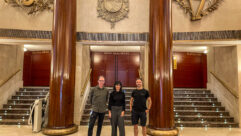
THE PLASMA DOCTOR IS IN THE HOUSE
Mar 1, 2002 12:00 PM,
PETER H. PUTMAN, CTS
LATELY IT SEEMS THAT 30% OF THE PRESS MATERIALS crossing my deskhave something to do with flat-screen video monitors and televisions,and the majority of these are plasma display panels.
There’s no question that the market for these unique,high-brightness, big-screen displays has mushroomed overnight, killingoff many lines of tube-based presentation monitors along the way.(Remember the NEC MultiSync and Mitsubishi MegaView 29-, 32- and37-inch CRTs?)
I have been testing and setting up plasma display panels for so longnow that I can barely remember getting my first review sample in 1997.Back then, there were no specific guidelines for setting up andcalibrating plasma, only borrowed guidelines for CRT imaging systems.So, I did what any reasonable person would have done: I devised my ownsetup and calibration procedure, using whatever tools I had onhand.
PLASMA PHYSIOLOGY — IT AIN’T CRT
it quickly became apparent that I would need to expand my collectionof test instruments. I also learned a lot about the peculiar imagingqualities of plasma panels, not the least of which is their non-linearresponse to changes in luminance levels. While a CRT is a purely lineardisplay (small changes in driving voltage result in equivalent changesin anode current and brightness), a PDP is not.
Instead, plasma panels use pulse-width modulation, a technique inwhich rapid on-off cycles can determine levels of luminance. The ratioof on cycles to off cycles within a given time interval translates intoa specific luminance level, so any instrument that is used to calibratea PDP must have an appropriate response time.
It gets better. You may have noticed that colors displayed on plasmapanels aren’t quite the same as those seen on CRTs. That’s partly dueto the emission process. An electrical discharge passing through apixel causes a burst of ultraviolet energy, which in turn“tickles” the phosphor and makes it glow. In comparison, aCRT stimulates phosphors with a high-energy electron beam. So, itstands to reason that this burst of UV energy will skew the color of aphosphor in a blue direction.
On some early panels, the overall image appeared to have agreen-yellow color cast. NEC Technologies (currently the largestmanufacturer of plasma) developed special filters to equalize thespectral response for a more lifelike picture. These capsulated colorfilters indeed shifted the color bias, but now there was more of a bluetint. Other schemes have been tried to produce CRT-like phosphorresponse, but the effects of UV color shift are still apparent withreds (they appear orange), greens (more of a lime green than a kelly orhunter green), and yellows (frequently shifting to a lemon, rather thanan amber color). It’s not unlike the effect observed with LCD and DLPprojectors using short-arc mercury vapor and other halide lamps (seeFigure 1).
BEFORE YOU OPERATE
in spite of allthis, it is possible to achieve a good white balance to a specificcolor temperature, once you know the co-ordinates for the colorphosphors. In a column last year, I detailed my efforts to measurecolor on a variety of non-standard light sources, including xenon,metal-halide, fluorescent and plasma emitters. I used a variety ofcolor sensors and analyzers, with the most accurate being a Minoltaspectraradiometer.

The difference between using a meter calibrated for CRT or daylightsources and one specifically set up to handle plasma phosphors wasn’thuge in most cases, but there was a difference of at least 300°K,and sometimes as much as 1000°K. This variance depended on theluminance level used to take the reading. A 40% to 80% gray fieldwasn’t as critical to measure, but pure whites and low grays (andblack) were all over the place.
The problem of calibrating plasma is compounded by the fact thatplasma panels are easily (and I mean easily) overdriven. Somemodels I tested recently can easily produce 90 to 100 nits (26 to 29ft/L) with a full 16×9 white field, and that number peaks over 100nits when image brightness enhancements (often labeled dynamicmode) are selected from the menu.
For small-area brightness, it’s not unusual to see measurements inthe range of 130 to 150 nits (38 to 44 ft/L). This level of brightnesscan definitely result in image burn-in if a stationary image is left onthe screen too long. Kicking up the brightness often pulls up blacklevels with it, which isn’t a bad thing for public concourses andsigns. But you sure don’t want that happening in a controlled lightingenvironment.
The truth is that with careful management of ambient lighting andconservative brightness levels, plasma panels can produce images veryclose to CRTs in many ways. I cannot say how or when I specificallyarrived at these levels, but I still set up panels to produce no morethan 75 to 90 nits (22 to 26 ft/L) for viewing SDTV and HDTV. Igenerally find these levels allow the panel to hold a dense black andpresent a smooth grayscale, plus the highest average contrast readingswill generally result.
That’s not to say that you can’t go higher; but, on some panels, youmay observe a color shift as brightness levels increase. The PWM methodof simulating analog response works pretty well — my new GEelectric range uses it to provide more control over the heatingelements — but even PWM has its limits.
THE GORY DETAILS
before calibration, make sure your plasma monitor is in itsstandard, non-enhanced mode. To establish the grayscale, first dialcontrast back to about 60 to 70 nits with a full white field. Somepanels from Fujitsu, Hitachi, Sony and NEC have an AGC circuit or APLcircuit that will drop the brightness level even more over severalminutes, so let the panel settle before proceeding.
I use a mix of test patterns, including the usual PLUGE from VideoEssentials (see Figure 2). PLUGE has a black background, plus one bar4% above black and another 4% below black, an area where video signalsare not normally viewed. In an RGB system, both of the bars may bevisible, or one will appear to be slightly darker than thebackground.
For RGB signals, adjust brightness to hold the background of thePLUGE pattern as black, with the 4%-above bar just showing. (For video,set the PLUGE bars as you would for a CRT.) I also toggle back andforth to the ANSI “Band-Aid” test pattern to clearly see85%, 90%, 95% and 100% white (See Figure 2, right). It takes somefiddling around, but once you can differentiate all four of the uppergray levels on the ANSI pattern while still holding the correct blacklevels with PLUGE, you are basically set.
Remember that overdriving contrast on a PDP won’t always result inthe same “blooming” artifacts or a bent needle pulse seenon a CRT monitor. Sometimes you may think the picture actually has alot more snap to it. But black levels will usually be degraded as aresult, and your linear grayscale will start coming apart. You’ll alsobe working the phosphors much, much harder, so be a littleconservative.
Once you have the grayscale just right and have established ballparkvalues for brightness and contrast, the next step is to adjust thecolor temperature. You’ll need a color analyzer with look-up tables forthe specific phosphors used in each panel. On some panels (NEC), colortemperature adjustment is easily done, as there is a PRO settingin the main menu that takes you to bias and drive for each colorchannel. On Panasonic panels, you’ll only have access to red and bluebias and drive. This means you have to pivot around a fixed setting ofgreen. It still works. You can get a nice match to D6500 on thePanasonic 42- and 50-inch models.
On Pioneer 502- and 503-series panels, you first need to access theintegrator service menu (that access code is different for professionalA/V and consumer models), but you’ll be rewarded with RGB bias anddrive settings. Fujitsu panels typically provide ready access to drivesettings for each color channel, but RGB bias isn’t easy to find (I’mstill looking for it). Sony provides access to RGB drive for amultitude of color temperature memories, while Hitachi requires thatone color channel drive setting must always remain at 255 while theother two are tweaked.
If you are working with a panel that only provides access to drive,put up a stepped grayscale ramp pattern (10 to 12 levels of gray) andpick a value around 40% or 50% gray to do your calibration. I used thismethod on a stabilized Fujitsu PDS-5002 50-inch PDP. The resultinggrayscale tracking measurements revealed the panel tracking within afew hundred degrees at most settings. The largest variances (600°and 300°) were at the low and high ends of the grayscale, and arecertainly acceptable for home and office use.
Make sure you save your hard work to memory! On some panels, simplyleaving the menu saves the settings. On others, you have to selectEnter or Save to retain the calibration. As long as thepanel remains plugged into an AC power source, you should be able torecall your calibration settings every time you power on the panel.
Like anything else, calibrating plasma monitors takes a little bitof practice. I’ve done enough of them now to move quickly through theinitial setup and get down to producing the most CRT-like images I can.Once done, the process makes a big improvement in image quality, andyou’ll start to understand why Japanese and Korean displaymanufacturers think plasma will be the next generation of televisionsets.
KNOW YOUR PATIENT: FIGURING OUT WHAT YOUR PLASMA DISPLAY ISMADE OF
Chances are, your panel came from one of these places: NEC, theFujitsu-Hitachi plasma factory, Pioneer or Panasonic. (Although therearen’t a lot of them out there yet, you will soon see panels comingfrom LG/Zenith and Samsung, and these will require their own phosphorlook-up tables.) My FSR color analyzer is loaded with specific phosphortables for each of the models listed (even the different phosphors inthe Pioneer PDP-502 and PDP-503), thanks to Cliff Plavin of ProgressiveLabs, who took the individual measurements.
Figuring out where your panel came from may require help from theFBI, though. I noticed a lot of cross breeding going on at CES 2002,with Fujitsu showing two panels (42 and 61 inches) made from NEC glass(Fujitsu’s PDS-5002 uses Panasonic glass). Sharp’s new 50-inch panel isactually a Pioneer PDP-503 in disguise, while Sony’s and Hitachi’s 32-and 42-inch panels use Fujitsu-Hitachi glass. The Marantz 61-inch panelhas an NEC PDP core, as do the 42-, 50- and 61-inch panels from RCA,Dreamvision and Runco.
Peter H. Putman owns PHP Communications, Doylestown, Pennsylvania.He is the author of The Toastmasters Guide to Audio/VisualPresentations.










